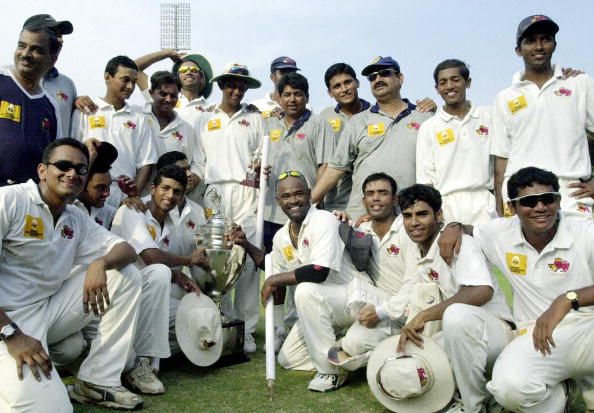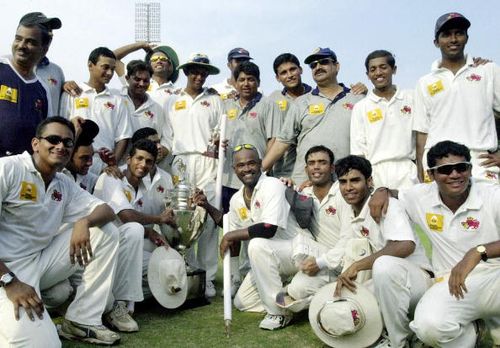
Celebrating 80 years of Ranji Trophy

Ranji Trophy, India’s premier First-Class (FC) tournament, turns 80 this year. With the advent of limited overs tournaments like Deodhar Trophy, Vijay Hazare Trophy, etc., it did lose its glitz but refused to die down. Ranji matches records and performances are still given the utmost importance when the national team is chosen. Here, we celebrate its 80th birthday with an overview of its history and heritage.
Birth
It was in a July 1934 meeting at Shimla that Anthony de Mello, the first secretary of the Board of Control for Cricket in India (BCCI), suggested the launch of ‘The Cricket Championship of India’ to the members assembled there. The idea was lapped up by Maharaja Bhupinder Singh of Patiala, who wanted it to be named after Kumar Shri Ranjitsinhji to honour his services to the game.
Ironically, Ranjitsinhji had never played for India and considered himself as an English cricketer. Like in all boardrooms, it was opposed by some members who wanted the championship to be named Willingdon Trophy after Lord Willingdon, the then Viceroy of India, to gain political advantage. But, in the end, like all things related with the BCCI these days, money took precedence over everything, and the trophy that was awarded to Bombay for winning the inaugural tournament was indeed the ‘Ranji Trophy’.
The Maharaja of Patiala had got his way.
Inaugural season
In the inaugural season, 15 teams participated from four zones in a knockout format. The first ever Ranji match was played between Mysore and Madras on November 4, 1934, at Chepauk. The visitors were all out for 48 in their first innings with as many as 5 players scoring ducks. Madras made 130 and managed to win the match by an innings and 23 runs, bowling out Mysore all out for 50 in the second innings. The match that was scheduled for 3 days got over in the first day itself in little more than 100 overs. It is the only FC match in India to finish on the first day. Bombay won the final match against Northern India to be crowned as champions.
Changes in format
From 1934-35 to 2001-02, the participating teams were grouped geographically in zones: North, East, West and South. Later, ‘Central’ was added in the 1952-53 season. Initially, the matches were played on a knockout basis within the zones; from 1956-57, they are being played on a league basis.
The top team from each zone qualified to compete in a knockout tournament. From the 1970-71 season, it was expanded to two teams; in 1992-93, it extended to 3 teams; between 1996-97 and 1999-2000, the 15 qualifying teams competed in a secondary group stage where 3 groups of 5 teams were formed, for the top two teams from each group to qualify for a 6-team knock out stage. In all the other years, till 2001-02, a full fifteen team knock-out tournament was held.
In 2002-03, the zonal system was scrapped, and it made way for the two division structure. The teams were divided into two groups: Elite group and Plate group. The top 15 teams in Elite Group were put into two subgroups, and the top two teams from each subgroup played a knockout tournament to win the Ranji Trophy. The teams that finished the last in the two subgroups were relegated to the Plate group, while the two teams that topped the Plate Group were promoted to Elite Group the following year.
In 2008-09, the format was adjusted to give the teams from Plate Group a chance at winning. The top two teams from each subgroup in the Plate Group played a knock out semi-final against each other, and the winners of the two matches went on to join the top three from each subgroup in the Elite group to play a 8-team knockout tournament. Rajasthan went on win the trophy in 2010-11 despite coming from the Plate Group.
In 2012-13, the format was again changed. The Elite Group and Plate Group made way for the group system. Three groups were formed: A, B and C. A and B are considered equal in status and have the top 15-18 teams, while the C group has the other nine teams. The top three teams from A and B and top two teams from C now participate in a knockout tournament. Similarly the top two teams from Group C are promoted to Group A and B, while the lowest placed teams from A and B are relegated to C.
The league matches are played for 4 days, while the knockout matches are played for full 5 days.
Point system
|
Case |
Points |
|
Win |
6 |
|
Draw |
1 |
|
First Innings Lead |
+2 |
|
Win by an innings or 10 wickets |
1 |
|
Lost |
0 |
|
Abandoned |
1 |
The first innings lead gave enough points to a team and hence was responsible for most of the teams rolling out flat pitches that did not assist the bowlers. Recently, the BCCI made it 6 points instead of 5 for an outright win to encourage more results in the matches.
In the earlier seasons, the opposing captains used to concede the match if they were made to field for too long. The most famous instance of this was when Bombay were playing Kathiawar at Pune in 1948-49: the captain of Kathiawar conceded the match when BB Nimbalkar was at 443, just 9 runs short of Bradman’s 452*, which was the highest FC score at that time.
Sacrifices made by the players
In a country where every second guy wants to be a national cricketer, it is tough to hold on to your place even in the state team. While everyone knows about Sachin Tendulkar returning in three days after performing his father’s last rites to score a match-winning and emotional 140 against Kenya in the 1999 World Cup, few are aware how, in 2006, Virat Kohli returned to play for his Delhi Ranji team in the morning after his father’s death the previous night.
A 1960s Mumbai opener Sudhakar Agnihotri married at 9:03 a.m. and reached the stadium at 10:30 a.m., because, if he had missed, his replacement would have got the chance. He returned to attend his reception in the evening. Another Mumbai batsman Eknath Solkar popularly known as ‘poor man’s Sobers’ helped his team win the Ranji final in 1968-69 despite his father having died the previous evening. Leading Indian pacer Mohammed Shami left home at the age of 16 to live with his coach Debrata Das before starting playing for Bengal Ranji team. These are just some of the cases that have made to the first page of the Google search, and there are countless others who have sacrificed their own wishes and desires to play for their teams.
Dominance of Bombay
If a team has managed to win in 40 seasons out of the 79 held, then the word ‘domination’ becomes an understatement. In other words, Bombay have owned the Ranji trophy since its inauguration. Out of the 44 times they have managed to reach the finals, they have won 40 times. From 1956-57 to 1976-77, Bombay won 20 times including 15 times in a row from 1958-59 to 1972-73. Distinguished Indian captains such as Vijay Merchant, Ravi Shastri and Sunil Gavaskar have come from the state.
But Bombay’s biggest contribution to world cricket has to be the ‘talented’ Rohit Sharma; well, of course not, its none other than our ‘Master Blaster’ Sachin Tendulkar. Currently, Ajinkya Rahane has been on the rise with a few others like Dhawal Kulkarni trying to find a permanent place in the India squad.
Those who missed out
Indians don’t consider a profession in sports to be of any importance unless it is cricket. If you are a cricketer representing India, you become entitled to people’s respect immediately. But, in a sport that has places only for the best XI of the country with politics, sadly, playing an important role, money has made sure many deserving candidates have almost always missed out. A G Ram Singh, a Madras all-rounder, couldn’t make it to the Indian team despite 265 wickets at an average of 18.56 and best figures of 8-14. He had 6 100s and 22 50s to his name, as well.
BB Nimbalkar, the man who nearly beat Bradman, never played for India despite scoring 4841 runs at an average of 56.72 in FC matches. His score of 434* remains the highest by a cricketer to have never played Test Cricket.
Rajinder Goel, who played Ranji Trophy for Haryana, Delhi, South Punjab and Patiala, never got to play for the country despite being the highest wicket-taker during his days. If 640 wickets couldn’t make the selectors think in the player’s favour, then I do not know what will.
Wasim Jaffer, another Mumbai opener, the record holder for the highest number of runs in Ranji Trophy, got to represent India in only 31 Tests and scored 1,944 runs at a not so bad average of 34.10. With the lack of quality openers around, only reasons known to the five wise-men (read: selectors), the right hander couldn’t cement a place in the Indian team.
Despite everything that is wrong with the BCCI and its selection policy, it has played its part in keeping Ranji Trophy afloat. Players are given good pays for playing Ranji matches, and there are also pension policies for retired players. Ranji trophy has churned out great players year after year since its inception. It has been strong for 80 years, and let us hope it continues to do so for years to come by.